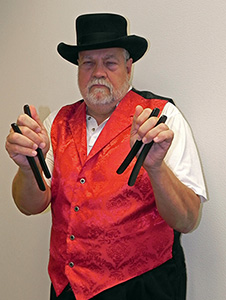UHV instructor keeps odd tradition alive, organizes upcoming Rhythm Bones Festival
A University of Houston-Victoria associate professor in the School of Education & Human Development sports a keen musical ear, keeps good time and has a penchant for offbeat musical instruments. And in his case, it’s no cliché to say he has rhythm in his bones.
Dennis Riedesel, a musician and history buff, is helping organize Rhythm Bones Fest XV June 9 to 12 in San Antonio. For the many uninitiated, rhythm bones are pieces of wood or actual bones that are held between the fingers and clicked together with rhythmic movements of each wrist.
“People used to say, ‘Rattle your bones,’ which meant to hurry up,” Riedesel said.
The rapid-fire clicking of the bones can be used to accompany fiddle or accordion, or to simply show off one’s percussive dexterity.
“These are played in a triplet pattern, as opposed to a two-beat,” he said. “You also use your wrists, as opposed to using the fingers like one does with castanets.”
Using bones as percussion instruments has been done since the Stone Age, and these types of bones have been excavated from Mesopotamian graves and depicted in Egyptian artwork dating back to 3,000 B.C. The instruments were used during turn of the 20th century minstrel shows, but today they are associated with Irish, English and Scottish folk music.
 |
| A rhythm bones kit owned by Riedesel includes instruments made of different types of bone and wood, plus a bone bow tie. |
After nearly becoming an extinct pastime, bones enthusiasts have kept the centuries-old tradition alive in part through the annual festival.
“In the mid-1980s, there were maybe 10 to 20 bones players that kept the tradition alive,” he said. “In the past 25 years, though, there has been a resurgence of interest with players using the Internet to better keep in contact.”
Riedesel guessed that there are 75 to 100 bones players in Texas alone and 300 to 500 nationwide.
An interest in the study of roots music has given rise to the renewed interest in rhythm bones. For the past 15 summers, bone rattlers have come together for a convention that features performances from the top players as well as community percussion events. Serious musicians make up a large part of the rhythm bones community, including an Irish national champion bones player, a former principal percussionist with the Grand Rapids (Mich.) Symphony, and one appropriately named character who goes by “Spike Bones.”
Riedesel’s interest in odd instruments has grown and now includes 15 or more hard-to-find noise-makers, including an American Indian courting flute, mouth bow, penny whistle, fife, mountain and hammer dulcimers, spoons, fiddle sticks, Greek lyre, Irish lap harp, one-string bass banjo and even an Australian didgeridoo. His “mainstream” instruments are accordion and harmonica.
“Yes, my wife is extremely patient, especially during those early months of learning a new instrument,” he said as he laughed. “But most of these instruments have a tie-in to history, so coupled with my interest in that, I am interested in these historical instruments.”
Riedesel teaches instructional design courses at UHV, and he specializes in teaching students how to teach.
“Teachers who have some musical ability can incorporate that into their instruction,” he said. “For instance, almost every decade of history has songs and music that pertain to it, and teachers can use this to make a history class more interesting.”
Lawrence Rossow, dean of the UHV School of Education & Human Development complimented Riedesel’s abilities.
“Dr. Riedesel’s interests in music and history help him to be a well-rounded instructor at UHV,” he said. “His broad interests and longtime service make him a strong part of our core faculty.”
Riedesel grew up among the rich German and Czech cultural traditions in Yorktown. His family had emigrated from Germany in 1848, and young Dennis grew up listening to his father and uncle trading songs on their button accordions on their home’s back porch after family dinners.
He began his musical career on the cornet, switching to tuba in high school. At Victoria College, he began studying string bass and performed with the Victoria Symphony during its first decade of existence.
His interest in bones grew out of serving on a crew of the IMAX movie “Alamo – The Price of Freedom” as both an extra and a period-costume consultant. During downtime between movie shots, Riedesel was entertained by a film crewman who was playing bones. And he had to have them.
During the past 20 years, Riedesel has collected bones of African black wood, Texas ironwood, cow rib and buffalo rib. He even made his own pair out of a piece of discarded Mammoth ivory.
For show, Riedesel sports a bone-shaped bow tie during performances, and he’ll probably be wearing it at next week’s Bones Fest in San Antonio.
“We look for unique places to hold the festival each year, and this time, we chose the middle of the country to try and attract more people who might have trouble traveling to the East or West coasts,” he said. The festival will be at the historic Emily Morgan Hotel near the Alamo.
Two performances will be free to the public. The festival group will perform at the Alamo Compound Amphitheater between 8:30 and 11 a.m. June 10 and 11.
Another public performance will be given from 6 to 9 p.m. June 10 during the Texas Folklife Festival at the Institute of Texan Cultures, but audience members must pay admission. For more information about the Bones Fest, visit the Rhythm Bones Society website at http://rhythmbones.com.
The University of Houston-Victoria, located in the heart of the Coastal Bend region since 1973 in Victoria, Texas, offers courses leading to more than 80 academic programs in the schools of Arts & Sciences; Business Administration; and Education, Health Professions & Human Development. UHV provides face-to-face classes at its Victoria campus, as well as an instructional site in Katy, Texas, and online classes that students can take from anywhere. UHV supports the American Association of State Colleges and Universities Opportunities for All initiative to increase awareness about state colleges and universities and the important role they have in providing a high-quality and accessible education to an increasingly diverse student population, as well as contributing to regional and state economic development.
Ken Cooke 361-570-4342








